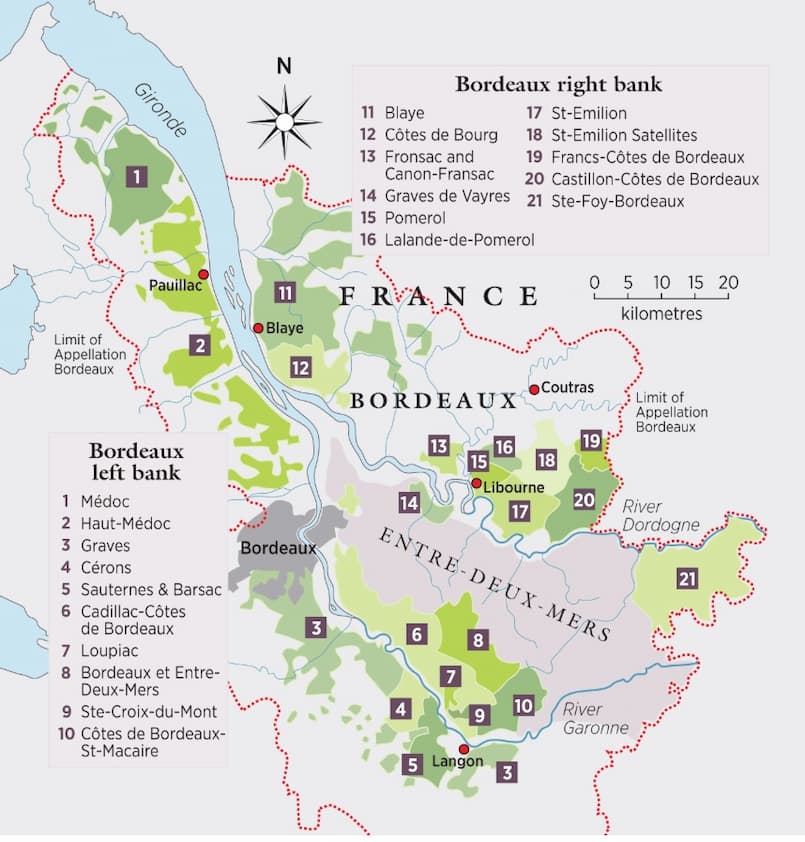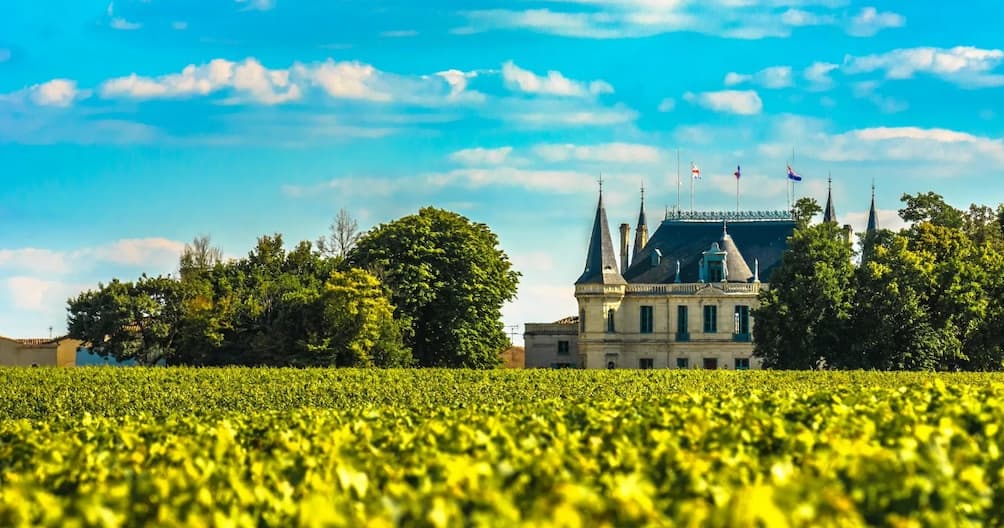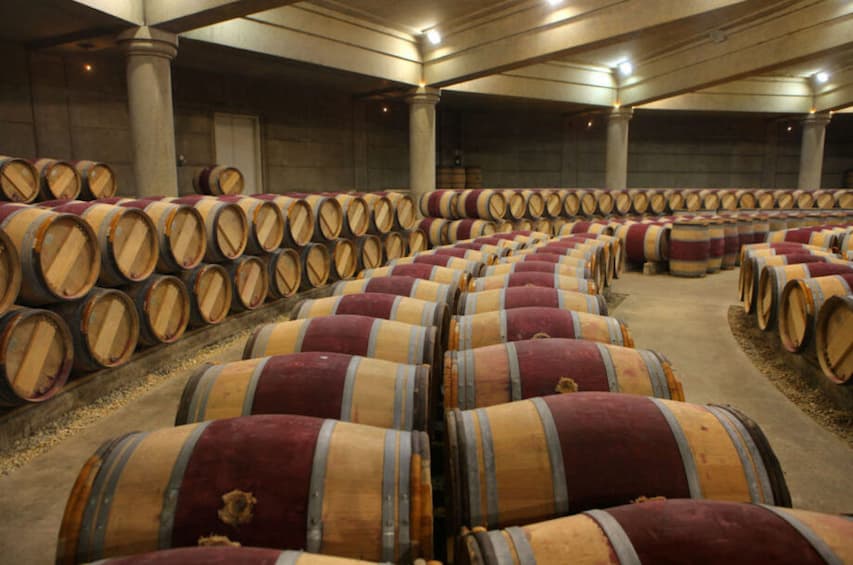Join us as we explore the storied terroirs of Bordeaux, from the gravelly Médoc to the limestone hills of Saint-Émilion — featuring estates that embody the region’s heritage, understated charm, and enduring elegance.
Saturday 21st June
2.00pm-5.00pm
Open on the day:
2.00pm-5.00pm
Open on the day:
'18 Château La Caussade Cadillac Côtes de Bordeaux $42
'18 Le Jardin de Queyron Pindefleurs Saint-Émilion $62
'18 Château Sénéjac Haut-Médoc $78
'16 Château Sérilhan Saint-Estèphe $90
'19 Blason d'Issan Margaux $125
'16 Château Mazeyres Pomerol $160
'16 Château Roumieu Sauternes 375ml $58
'18 Le Jardin de Queyron Pindefleurs Saint-Émilion $62
'18 Château Sénéjac Haut-Médoc $78
'16 Château Sérilhan Saint-Estèphe $90
'19 Blason d'Issan Margaux $125
'16 Château Mazeyres Pomerol $160
'16 Château Roumieu Sauternes 375ml $58
Enjoy a 10% discount when you purchase any three bottles on the day.
Hosted by James Johnston of World Wine Estates, and free of charge.

Bordeaux: A Deep Dive into France's Largest Wine Region
Bordeaux, located in the southwest of France, is the country’s largest wine region, with more than 117,000 hectares of vineyards producing around 5-6 million hectoliters of wine annually. This iconic wine-producing area accounts for nearly 14% of France’s total vineyard acreage, offering a wide array of wine styles. Bordeaux’s vineyards span both sides of the Garonne and Dordogne Rivers and stretch over 130 kilometers, encompassing diverse sub-regions with varying climates and terroirs.
The Bordeaux Landscape: Left Bank vs. Right Bank
Bordeaux is traditionally divided into two main sections: the Left Bank and the Right Bank.
The Left Bank: This area, including the Médoc and Graves, is known for its gravelly soils and proximity to the Atlantic Ocean. These conditions are ideal for growing Cabernet Sauvignon, the backbone of many Bordeaux reds. The Médoc, in particular, is famous for producing some of the world’s most prestigious wines, with communes like Pauillac, Saint-Estèphe, and Margaux housing classified estates, including Château Lafite Rothschild and Château Margaux.
The Right Bank: Comprising regions such as Saint-Émilion and Pomerol, the Right Bank is characterized by clay-rich soils and a more temperate climate. This soil profile is particularly suited for Merlot, which thrives here and often produces wines that are softer and fruitier than their Left Bank counterparts. Notable Right Bank estates include Château Cheval Blanc in Saint-Émilion and Petrus in Pomerol.
In between the two banks lies Entre-Deux-Mers, an expansive area known for producing a significant portion of Bordeaux’s white wines. The Blaye and Bourg regions, located to the northeast of the Right Bank, are emerging as areas of interest for both red and white wines, though they are often overlooked compared to Bordeaux’s more famous sub-regions.
Bordeaux's Climate and its Impact on Wine
Bordeaux's climate is heavily influenced by the Atlantic Ocean, moderated by the Gironde Estuary. This maritime climate offers mild winters and warm summers, though the weather can be unpredictable. While rainfall is relatively even throughout the year, it can cause problems during harvest, especially for later-ripening grapes like Cabernet Sauvignon and Petit Verdot. These weather patterns contribute to significant vintage variation, resulting in both exceptional years and difficult harvests.
The region benefits from warm temperatures due to the Gulf Stream, which brings warmth from the Caribbean, allowing vines to grow in ideal conditions. However, the region’s proximity to the ocean also means that spring frosts and fall rains can sometimes disrupt the growing season, causing fluctuations in yields and quality.
Key Bordeaux Grapes: Merlot, Cabernet Sauvignon, and More
Bordeaux is home to a wide range of grape varieties, but the three most important are Merlot, Cabernet Sauvignon, and Cabernet Franc. These varieties are blended to create Bordeaux’s signature red wines, with Merlot dominant on the Right Bank and Cabernet Sauvignon ruling the Left Bank.
Merlot: This is the most widely planted grape in Bordeaux, particularly on the Right Bank. Known for its smooth, approachable character, Merlot produces wines with rich fruit flavors and a soft texture, often with notes of plums, blackberries, and chocolate.
Cabernet Sauvignon: The key grape on the Left Bank, Cabernet Sauvignon is known for its tannic structure, bold flavors, and aging potential. It imparts deep, dark fruit flavors, with notes of blackcurrant and tobacco, and often requires several years of aging to reach its full potential.
Cabernet Franc: While less prominent than Merlot and Cabernet Sauvignon, Cabernet Franc is a crucial component of many Bordeaux blends, especially on the Right Bank. It adds acidity, freshness, and aromatic complexity, with flavors of herbs, pepper, and red fruits.
Bordeaux also produces some white wines, mainly from Sauvignon Blanc and Sémillon, with Muscadelle being a lesser-known component in some blends. The whites range from crisp and citrusy to richer, barrel-aged styles, with Sauternes being famous for its sweet, botrytized wines.
The Bordeaux Wine Style
Bordeaux wines, whether red, white, or sweet, are often blends of several grape varieties. This blending is essential for mitigating the unpredictable climate. By using different varieties that ripen at different times, winemakers can protect against weather-related issues that may affect one grape but not another. The result is a balanced and complex wine.
Red Bordeaux: These wines are typically blends of Merlot and Cabernet Sauvignon, sometimes with Cabernet Franc and small amounts of other grapes. The reds are known for their structure, tannins, and ability to age well, often showing complex flavors of dark fruit, spice, and earthy notes with aging.
White Bordeaux: Made primarily from Sauvignon Blanc and Sémillon, these wines range from light and fresh to more full-bodied, with flavors of citrus, grass, and tropical fruits. The whites from Graves and Pessac-Léognan are highly prized for their depth and complexity.
Sauternes and Barsac: These regions are famous for their sweet wines made from grapes affected by noble rot (Botrytis cinerea). The process concentrates the sugars in the grapes, resulting in wines with intense flavors of honey, dried fruit, and spice. These wines are among the finest dessert wines in the world.
History of Bordeaux: From Roman Times to the Present
The history of Bordeaux wines dates back to Roman times, when the first vineyards were planted in the region. Bordeaux rose to prominence under English rule in the 12th century, with the marriage of Eleanor of Aquitaine to Henry II of England sparking a long-lasting trade relationship between Bordeaux and England. The English developed a taste for Bordeaux wines, especially the light red wines called clairet, which eventually evolved into the modern red Bordeaux style.
Over the centuries, Bordeaux has faced numerous challenges, from wars to phylloxera, which devastated the vineyards in the late 19th century. However, the region rebounded with innovations in viticulture and winemaking, becoming the global wine powerhouse it is today. In the 20th century, Bordeaux faced economic hardships, including the global impact of two World Wars and the decline of the English market. Despite these struggles, Bordeaux remains a key player in the world of fine wine.
Modern Bordeaux: Challenges and Opportunities
Today, Bordeaux faces the challenges of climate change, with increasing temperatures affecting grape ripening and harvest dates. However, the region is adapting by embracing sustainable practices, including organic and biodynamic viticulture, and exploring new grape varieties to cope with environmental changes.
Despite fluctuations in global demand, Bordeaux wines are still some of the most highly sought after in the world. The region’s wines command top prices at auctions, especially the prestigious First Growths of the 1855 Classification, such as Château Lafite Rothschild, Château Latour, and Château Margaux. While the prices of these wines can be astronomical, Bordeaux also produces a wide range of more accessible wines, making it a region for every wine lover.
As Bordeaux continues to evolve, it remains committed to producing wines that showcase its unique terroirs and rich history. Whether you're a collector or a casual enthusiast, Bordeaux offers wines that are as diverse and dynamic as the region itself, promising something for every palate.

The Wines
2018 Château La Caussade Cadillac Côtes de Bordeaux
Château La Caussade, established in 1766, is one of the oldest and most renowned vineyards in the Bordeaux region. Situated in the Cadillac Côtes de Bordeaux appellation, the estate benefits from clay-limestone soils that contribute to the complexity of its wines. The 2018 vintage is a blend of 60% Merlot and 40% Cabernet Sauvignon, crafted using traditional methods in stainless steel tanks. The Merlot is harvested manually, while the Cabernet Sauvignon is mechanically harvested at optimal ripeness. This wine is designed to be enjoyed within two years to appreciate its freshness and fruit-forward character.
Château La Caussade, established in 1766, is one of the oldest and most renowned vineyards in the Bordeaux region. Situated in the Cadillac Côtes de Bordeaux appellation, the estate benefits from clay-limestone soils that contribute to the complexity of its wines. The 2018 vintage is a blend of 60% Merlot and 40% Cabernet Sauvignon, crafted using traditional methods in stainless steel tanks. The Merlot is harvested manually, while the Cabernet Sauvignon is mechanically harvested at optimal ripeness. This wine is designed to be enjoyed within two years to appreciate its freshness and fruit-forward character.
Tasting Note: A vibrant red wine with notes of ripe red fruits, balanced acidity, and soft tannins, making it an excellent companion to roasted chicken or firm-fleshed fish.
2018 Le Jardin de Queyron Pindefleurs Saint-Émilion
Located at the foot of the southern slopes of Saint-Émilion, Château Queyron Pindefleurs has been in the Fillon family since 1937 and is currently managed by Chantal and Peter Watts. The estate spans 14 hectares of clay-limestone soils, ideal for cultivating Merlot-dominant blends. The 2018 vintage, known for its richness and concentration, offers deep aromas of red fruits and sweet spices. This wine reflects the elegance and structure characteristic of Saint-Émilion wines.
Located at the foot of the southern slopes of Saint-Émilion, Château Queyron Pindefleurs has been in the Fillon family since 1937 and is currently managed by Chantal and Peter Watts. The estate spans 14 hectares of clay-limestone soils, ideal for cultivating Merlot-dominant blends. The 2018 vintage, known for its richness and concentration, offers deep aromas of red fruits and sweet spices. This wine reflects the elegance and structure characteristic of Saint-Émilion wines.
Tasting Note: An elegant wine showcasing deep red fruit aromas and subtle sweet spice notes, embodying the finesse of Saint-Émilion terroir.
2018 Château Sénéjac Haut-Médoc
Château Sénéjac is a distinguished estate in the Haut-Médoc region, known for producing wines that are silky, well-integrated, and aromatically refined. The 2018 vintage is a testament to the estate's commitment to quality, offering a wine that is both approachable and expressive of its terroir.
Château Sénéjac is a distinguished estate in the Haut-Médoc region, known for producing wines that are silky, well-integrated, and aromatically refined. The 2018 vintage is a testament to the estate's commitment to quality, offering a wine that is both approachable and expressive of its terroir.
Tasting Note: A harmonious blend with notes of oak, vanilla, and black fruits, delivering a smooth and elegant palate experience.
2016 Château Sérilhan Cru Bourgeois Saint-Estèphe
Château Sérilhan, a Cru Bourgeois estate in Saint-Estèphe, is celebrated for its meticulous viticulture and traditional winemaking techniques. The 2016 vintage comprises 54% Cabernet Sauvignon, 44% Merlot, and 2% Cabernet Franc, aged for 15 months in barrels (37% new). This wine exhibits a deep purple hue, with complex aromas of blackberry, cassis, violets, and a hint of smokiness. On the palate, it offers intense flavors of dark fruits, dark chocolate, and spices, supported by well-integrated tannins and a persistent finish.
Château Sérilhan, a Cru Bourgeois estate in Saint-Estèphe, is celebrated for its meticulous viticulture and traditional winemaking techniques. The 2016 vintage comprises 54% Cabernet Sauvignon, 44% Merlot, and 2% Cabernet Franc, aged for 15 months in barrels (37% new). This wine exhibits a deep purple hue, with complex aromas of blackberry, cassis, violets, and a hint of smokiness. On the palate, it offers intense flavors of dark fruits, dark chocolate, and spices, supported by well-integrated tannins and a persistent finish.
Tasting Note: A rich and structured wine with layers of dark fruit, chocolate, and spice, culminating in a long, satisfying finish.
2019 Blason d'Issan Margaux
Blason d'Issan is the second wine of Château d'Issan, crafted from younger vines yet embodying the elegance of Margaux. The 2019 vintage is a blend of 60% Merlot and 40% Cabernet Sauvignon, offering a balanced profile with soft tannins. This wine is approachable in its youth, displaying intense red color with purple reflections and aromas of black fruits, blackcurrant, cherry, complemented by woody and vanilla notes.
Blason d'Issan is the second wine of Château d'Issan, crafted from younger vines yet embodying the elegance of Margaux. The 2019 vintage is a blend of 60% Merlot and 40% Cabernet Sauvignon, offering a balanced profile with soft tannins. This wine is approachable in its youth, displaying intense red color with purple reflections and aromas of black fruits, blackcurrant, cherry, complemented by woody and vanilla notes.
Tasting Note: A balanced and approachable Margaux with soft tannins and a bouquet of blackcurrant, cherry, and subtle vanilla.
2016 Château Mazeyres Pomerol
Château Mazeyres, situated in Pomerol, practices organic and biodynamic viticulture, enhancing the expression of its terroir. The 2016 vintage reveals a distinguished nose with aromas of white peach, violet, and dried fruits. The palate is soft and smooth, offering a fresh and crisp experience, with a refined and lingering finish featuring red fruit and almond notes.
Château Mazeyres, situated in Pomerol, practices organic and biodynamic viticulture, enhancing the expression of its terroir. The 2016 vintage reveals a distinguished nose with aromas of white peach, violet, and dried fruits. The palate is soft and smooth, offering a fresh and crisp experience, with a refined and lingering finish featuring red fruit and almond notes.
Tasting Note: A refined Pomerol with delicate aromas and a silky palate, culminating in a fresh, lingering finish.
2016 Château Roumieu Sauternes
Château Roumieu, located in the Sauternes appellation, produces sweet wines that balance decadent sweetness with refreshing acidity. The 2016 vintage is composed of 89% Sémillon, 10% Sauvignon Blanc, and 1% Muscadelle, offering a complex profile with honeyed notes and vibrant freshness. This wine is versatile, pairing well with a variety of dishes, from foie gras to cheeses and desserts.
Château Roumieu, located in the Sauternes appellation, produces sweet wines that balance decadent sweetness with refreshing acidity. The 2016 vintage is composed of 89% Sémillon, 10% Sauvignon Blanc, and 1% Muscadelle, offering a complex profile with honeyed notes and vibrant freshness. This wine is versatile, pairing well with a variety of dishes, from foie gras to cheeses and desserts.
Tasting Note: A luscious Sauternes with rich honeyed flavors balanced by vibrant acidity, offering versatility in food pairings.


